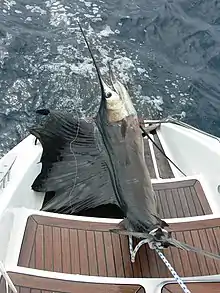| Indo-Pacific sailfish | |
|---|---|
 | |
| Scientific classification | |
| Domain: | Eukaryota |
| Kingdom: | Animalia |
| Phylum: | Chordata |
| Class: | Actinopterygii |
| Order: | Istiophoriformes |
| Family: | Istiophoridae |
| Genus: | Istiophorus |
| Species: | I. platypterus[1] |
| Binomial name | |
| Istiophorus platypterus[2] (Shaw, 1792) | |
| Synonyms[3] | |
| |

The Indo-Pacific sailfish (Istiophorus platypterus) is a sailfish native to the Indian and Pacific Oceans and is naturalized in the Atlantic where it has entered the Mediterranean Sea via the Suez Canal as a Lessepsian migrant.[4] It is dark blue on top, brown-blue laterally, silvery white underbelly; upper jaw elongated in the form of a spear; first dorsal fin greatly enlarged in the form of a sail, with many black cones, its front squared off, highest at its midpoint; pelvic fins very narrow, reaching almost to the anus; body covered with embedded scales, blunt at end; lateral line curved above pectoral fin, then straight to base of tail. They have a large and sharp bill, which they use for hunting. They feed on tuna and mackerel, some of the fastest fish in the Ocean. Most authorities only recognise a single species of sailfish, I. platypterus.[3]
It is theorized by marine biologists that the 'sail' (dorsal fin array) of the sailfish may serve the purpose of a cooling and heating system for this fish; this due to a network of a large number of blood vessels found in the sail and because of "sail-raising" behaviour exhibited by the sailfish at or near the surface waters after or before high-speed bursts.
The IUCN recognizes this species as the cosmopolitan sailfish, where FishBase recognizes two species.
Fisheries
Common and widespread in the tropical and sub-tropical Atlantic and Indo-Pacific oceans, ranging into temperate waters.
Although targeted in some areas, the species is mostly taken as bycatch by tuna longliners. Sailfish are not as highly valued as marlin, and are usually released. They are considered a hard-fighting game fish by recreational anglers.

References
- ↑ "Istiophorus platypterus". Integrated Taxonomic Information System. Retrieved 18 April 2006.
- ↑ "Istiophorus platypterus". Integrated Taxonomic Information System. Retrieved 18 April 2006.
- 1 2 Froese, Rainer; Pauly, Daniel (eds.) (2018). "Istiophorus platypterus" in FishBase. February 2018 version.
- ↑ Collette, B.B.; Di Natale, A.; Fox, W.; Graves, J.; Juan Jorda, M.; Pohlot, B.; Restrepo, V.; Schratwieser, J. (2022). "Istiophorus platypterus". The IUCN Red List of Threatened Species. 2022: e.T170338A46649664. Retrieved 2 August 2022.
